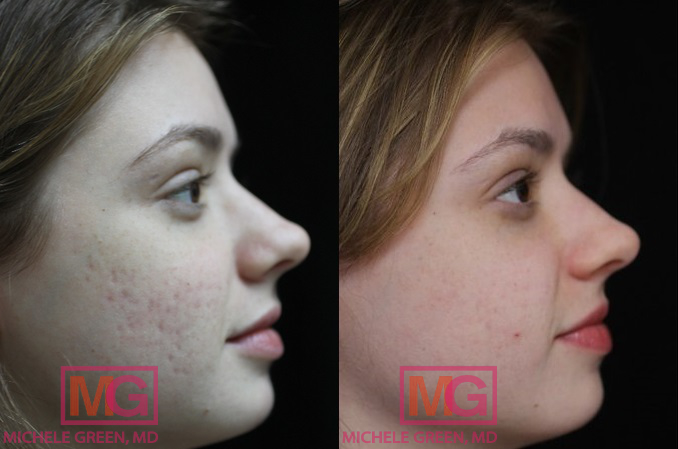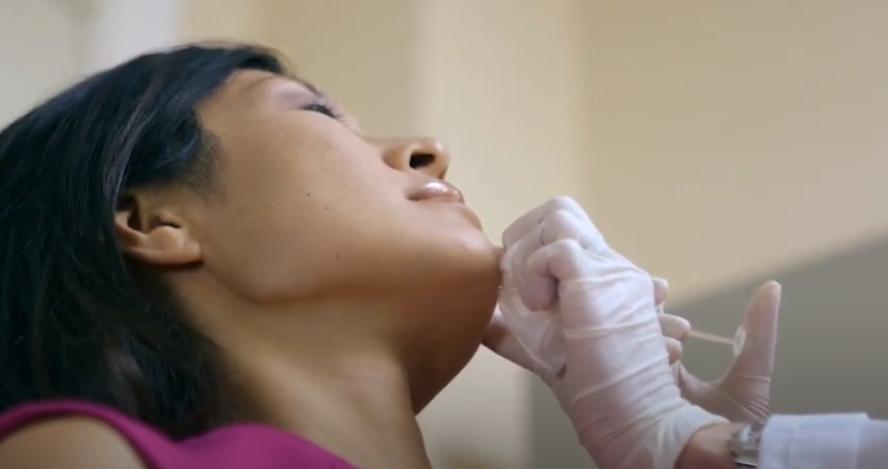TCA Cross Acne Scars
Dr. Michele Green in New York is a world expert in acne scar treatment and has perfected numerous cosmetic treatments to improve the appearance of acne scars, including laser resurfacing, chemical peels, microneedling, dermal fillers, laser treatments, subcision, and TCA Cross. Dr. Michele Green uses TCA Cross to reduce the appearance of enlarged pores and elevate deep ice-pick and boxcar scars. TCA Cross, trichloroacetic acid chemical reconstruction of skin scars, is a cutting-edge treatment that only a few dermatologists successfully perform. Dr. Green specializes in treating acne scars in patients of all skin types, including Asian, Hispanic, Caucasian, and darker skin tones. Each unique skin type and type of acne scarring requires a particular acne scar treatment. Dr. Green will customize the best acne scar treatment for you through chemical peels, TCA Cross, laser treatments, dermal fillers, and skin care products to rejuvenate your skin and improve your acne scars.
For over two decades, Dr. Green has perfected the use of TCA cross to treat acne scars. TCA cross is a highly popular type of acne scar treatment that reduces the appearance of scars by stimulating new collagen production to create a smoother, more beautiful skin texture. The TCA cross technique entails the direct application of trichloroacetic acid to acne scars with a small applicator, such as a toothpick. TCA cross works best for atrophic acne scars, such as icepick and boxcar scars. To guarantee optimal cosmetic results and prevent potential unwanted side effects such as scarring or hyperpigmentation, it is always recommended to have TCA cross-treatment with an experienced board-certified dermatologist, such as Dr. Michele Green in New York City.
Dr. Michele Green is an internationally renowned board-certified dermatologist with a special interest in treating acne scars and skin discoloration. Dr. Green has over two and a half decades of experience providing some of the world’s most discerning men and women with the best non-invasive treatment options for skin rejuvenation, including TCA cross-treatment for acne scars. Whether the scars are atrophic, such as ice pick scars and boxcar scars, rolling, hyperpigmented, hypertrophic, or keloid, Dr. Green utilizes the most cutting-edge treatments and technologies to help reduce acne scarring. For her dedication to her patients and expertise, Dr. Green is consistently identified as one of New York City’s best dermatologists by Castle Connolly, New York Magazine and Super Doctors. When you consult with Dr. Green, she will work with you to create a customized acne scar treatment plan best suited to your skin type, skin tone, and the types of acne scars present.
What is TCA Cross?
TCA is an abbreviation for trichloroacetic acid, the chemical acid used by Dr. Green for chemical peels and TCA Cross treatment. “Cross” is an acronym for the chemical reconstruction of skin scars method, using a strong trichloroacetic acid placed directly into atrophic scars. TCA Cross was invented many years ago by a Korean Dermatologist and is uniquely suitable for treating ice-pick acne scars. TCA Cross is used primarily in boxcar scars, rolling acne scars, and ice-pick scars. Minute amounts of TCA, in high concentrations (70 to 100%), are deposited directly into the surface of the atrophic scar. The goal of TCA Cross is to stimulate the formation of new elastin and collagen production. TCA Cross can be used on most skin types (TCA Cross is not suitable for skin types 3 or darker), with typically 3 to 5 treatments spaced 6-8 weeks apart for the best cosmetic results. For some patients with atrophic scars, TCA Cross works even better than Fraxel (TM) laser treatments. TCA Cross treatments are safe and effective, with minimal discomfort.
What are the 3 main types of acne scars?
- Atrophic scars: These can be further divided into ice-pick scars (60%, narrow and deep), boxcar scars (25% and wide), and rolling (15% ). Ice pick scars can be some of the most difficult acne scars to treat.
- Hypertrophic scars
- Keloidal scars
How does TCA Cross work for ice-pick scars?
TCA Cross treats the depression, or area of scarring itself, and not the surrounding skin. The acid is directly deposited with the edge of a syringe or a toothpick/applicator into the atrophic scar, leaving the entire skin surrounding the scar preserved. TCA Cross can also treat deep open pores, prominent pores, and box car scars. Depending on the skin type and the type of acne scar, up to 100% TCA treats these deep ice-pick scars. The recovery time is generally less than one week from the procedure. Special emollients and sunscreen are recommended after the procedure, as well as complete sun avoidance to avoid hyperpigmentation. Depending on your skin type, 3 to 4 sessions are needed best to improve the cosmetic appearance of your acne scars. TCA Cross can also be combined with dermal filler injections, such as Juvederm, Restylane, and Sculptra, and various laser treatments.
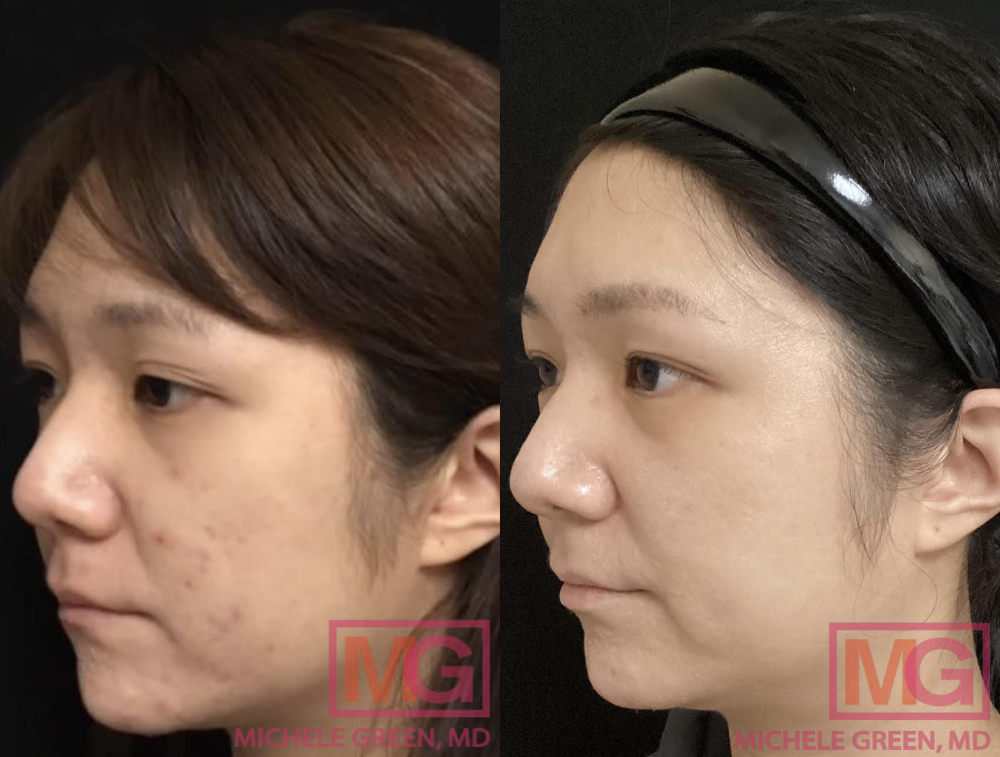
TCA Cross works on the scar by helping to denature the collagen within the scar tissue at the dermis layer and stimulate new, healthy collagen production. New collagen production begins as early as 4 weeks after the procedure and continues to form up to 4 months after each TCA Cross treatment. As the new collagen remodels in your acne scars, new tissue is formed, which produces a noticeable improvement in your scars.
How is the TCA Cross technique performed?
- TCA Cross should not be performed on skin that is sun damaged or has recently had laser treatments, microneedling, chemical peels, or other skin treatments.
- Discontinue use of all Retinols, Retinoids, Tazorac, alpha hydroxy acids, or exfoliants for 3 days before TCA Cross is performed.
- Patients with darker skin types may need to pre-treat with skin-lightening creams for several weeks before the procedure. TCA Cross is not suitable for skin types 3 or darker.
- Patients should avoid tanning and direct sun exposure for 2 weeks before reaching treatment.
- Refrain from wearing makeup or using other skin care products on the day of the procedure.
- At the start of the procedure, the skin is degreased with alcohol before applying any trichloroacetic acid.
- Photos are taken of the treatment area to document the procedure’s progress.
- Each scar is carefully treated with between 50 and 100 % TCA, and each area is neutralized with water directly after treatment.
- After the acid is applied, you will observe frosting of the skin where the treated area initially turns white and later red.
- Each atrophic scar is treated with the acid on a wooden applicator, toothpick, or insulin syringe.
- Each lesion then scabs after a few days, creating wounds that heal to generate new skin.
- The entire treatment takes between 15 and 30 minutes, depending on the amount of acne scarring.
- Proper skin care and sunscreen use are reviewed after the procedure, and strict sun avoidance is recommended.
- Downtime is generally 5 to 7 days.
- Hydroquinone creams are commonly prescribed for darker skin patients.
- Refrain from makeup after the procedure for several days until the skin heals and returns to normal. Lycogel may be able to be used post-laser.
Does TCA Cross work for acne scars?
Yes. In many cases, TCA Cross treatment works better for certain atrophic acne scars than laser treatments. Darker skin types may need to use a 50% TCA solution to treat their scars, as opposed to 100% TCA in lighter skin patients. Due to the weaker strength of an acid in darker skin tones, more TCA Cross treatments may be needed to reduce unwanted acne scars. The TCA concentrations differ, and the correct strength is based on the type of scar and the skin type of the patient. Meticulous treatment must be performed using TCA Cross to prevent pigmentation changes or worsening of acne scarring. Hydroquinones are commonly prescribed by Dr. Green in darker-skinned patients to be used before your treatment and for several weeks after TCA cross to prevent and treat resulting hyperpigmentation.
What is the difference between a trichloroacetic acid peel (TCA peel) and TCA cross?
The main difference between TCA Cross and a TCA chemical peel is that TCA Cross treats individual acne scars with a very high concentration (50 to 100%)of trichloroacetic acid. A TCA chemical peel is generally at much lower concentrations, from 10 to 30%, and treats the entire face, chest, back, arms, or buttocks. TCA chemical peels treat discoloration, sun damage, actinic keratoses, hyperpigmentation, brown spots, sun spots, fine lines, wrinkles, and acne breakouts. Chemical peels are very effective in treating various skin conditions and generally require a series of peels to effect the most change. TCA peels improve skin texture, tone, and overall complexion. When you consult with board-certified dermatologist Dr. Michele Green in her private dermatology office in NYC, she will evaluate the types of acne scars present and recommend the acne scar treatments best suited to reducing their appearance and providing smooth, clear skin.
How many treatments of TCA Cross are needed?
Generally, three to four TCA Cross treatments are needed for the best cosmetic results. Patients with deep acne scars may need more treatments. TCA Cross treatments should be performed six to eight weeks apart or longer. Patients with darker skin tones or deep scars may require more than four treatments. Dr. Green will work with you to create a personalized treatment plan for skin rejuvenation that incorporates in-office procedures and specially formulated skincare products for achieving and maintaining healthy, smooth, clear skin.
How often can I do TCA Cross for acne scars?
It is best to wait 6 to 8 weeks after TCA Cross before having the next treatment session. This time period allows the skin to heal, any discoloration to be treated, and new collagen and elastin to start remodeling. Dr. Green will physically assess your skin condition during each follow-up appointment to evaluate the progress of your acne scars. Many patients with acne scars choose to take a combination approach, as it is the most efficient way to reduce the appearance of scars and create a smoother skin texture. Patients engaging in a combination acne scar treatment approach may have intermittent treatment sessions of procedures such as laser treatments, microneedling, or subcision with dermal fillers, depending on their specific concerns and unique needs. When you consult with Dr. Green in NYC, she will work with you to create a customized treatment plan and establish a timeline for treatment that works best for your needs.
Are the results of TCA Cross permanent?
The positive results that you experience from the treatment of acne scars with TCA Cross are permanent. TCA Cross will help remodel and produce new collagen in your atrophic acne scars and will be a step forward in combining other modalities and treatment options to improve the cosmetic appearance of your acne scars.
Does TCA Cross hurt?
TCA Cross is not painful at all. Each tiny amount of TCA placed in each acne scar feels like a tiny sting. There is no need for any topical numbing cream with this procedure.
What is the downtime for TCA Cross?
Most patients have between 5 and 7 days of downtime after the procedure. Strict skin care and sun avoidance need to be maintained after TCA Cross. Some patients can experience redness or hyperpigmentation for several weeks after treatment.
What should I do post-op after TCA Cross?
Use of SPF 50 or higher daily, hats, and direct sun avoidance are all essential to have the best cosmetic results. Emollients are used several times daily to allow the skin to heal properly after the procedure. Avoid being overheated, excessive exercise, and avoid hot tubs, saunas, steam rooms, or excessively hot showers in the first 3 days after treatment. Regular home skin care products can be resumed once your skin returns to normal. Avoid picking, scrubbing, or exfoliating the skin after the procedure to prevent acne scarring. Avoid electrolysis, waxing, or any hair removal for the area for at least 2 weeks after your treatment.
Can I do TCA Cross at home?
No. TCA Cross uses a very high medical-grade acid that only physicians like Dr. Green are licensed to use, requiring expert skill and knowledge to use effectively and safely. Serious and damaging side effects may result from improper TCA cross technique, including hyperpigmentation, hypopigmentation, and scarring. For this reason, it is always recommended to have TCA cross and other acne scar treatments with an experienced board-certified dermatologist, such as Dr. Green in NYC.
What are the side effects of TCA Cross?
- One of the main potential side effects, especially in darker skin types, is post-inflammatory hyperpigmentation or PIH. Darker skin types are more susceptible to discoloration, especially when utilizing these higher-strength trichloroacetic acid solutions. This skin darkening can last for several months and fade over time. Many patients will use a bleaching cream with hydroquinone or Cosmelan for several months, a week after TCA cross, to treat this PIH. Strict sun avoidance is always necessary to lessen the side effect of facial discoloration and pigmentation.
- Hypopigmentation is a possible side effect and may be permanent.
- Erythema and local irritation from the procedure
- Increased acne scarring
- Infections
- Scarring
- Blisters
- Allergic reactions
- Peeling
- Acne breakout
- Activation of viral infections such as herpes simplex
Which procedures can be done with TCA Cross?
Treating acne scars usually requires a combination of treatments. Although TCA Cross can be used alone to treat some patients with atrophic scars, many patients require a combination of treatments to have the best cosmetic results, including:
- Subcision
- Microneedling with Dermapen or Eclipse Micropen
- Platelet Rich Plasma facials
- Fraxel for fractional laser treatment
- eMatrix radiofrequency laser treatment
- Punch excision
- CO2 laser
- Erbium laser
- Bellafill
- Hyaluronic acid fillers such as Restylane and Juvederm
- Dermal fillers like Sculptra
- Laser resurfacing
- Vbeam laser treatment
- IPL or Excel V
- Topical retinoids
Is TCA Cross the best treatment for all acne scars?
Acne scars are unique to each individual, and a customized treatment plan needs to be created for each patient. Dr. Green will create a tailored treatment plan for you since each pattern of acne scarring needs to be based on your individual needs. Whether it be combining TCA Cross with punch excision or dermal fillers, or laser treatment, Dr. Green will create the best treatment plan for you.
Am I a good candidate for TCA Cross?
The best way to determine if you are the best candidate for TCA Cross is to schedule an in-person consultation with an acne scar specialist and board-certified dermatologist like Dr. Michele Green. She will examine your pattern of acne scars and identity the best treatment methods to help you address these scars. A unique treatment plan will be designed based on your unique needs and cosmetic goals. Please note that TCA Cross is unsuitable for skin types 3 or darker.
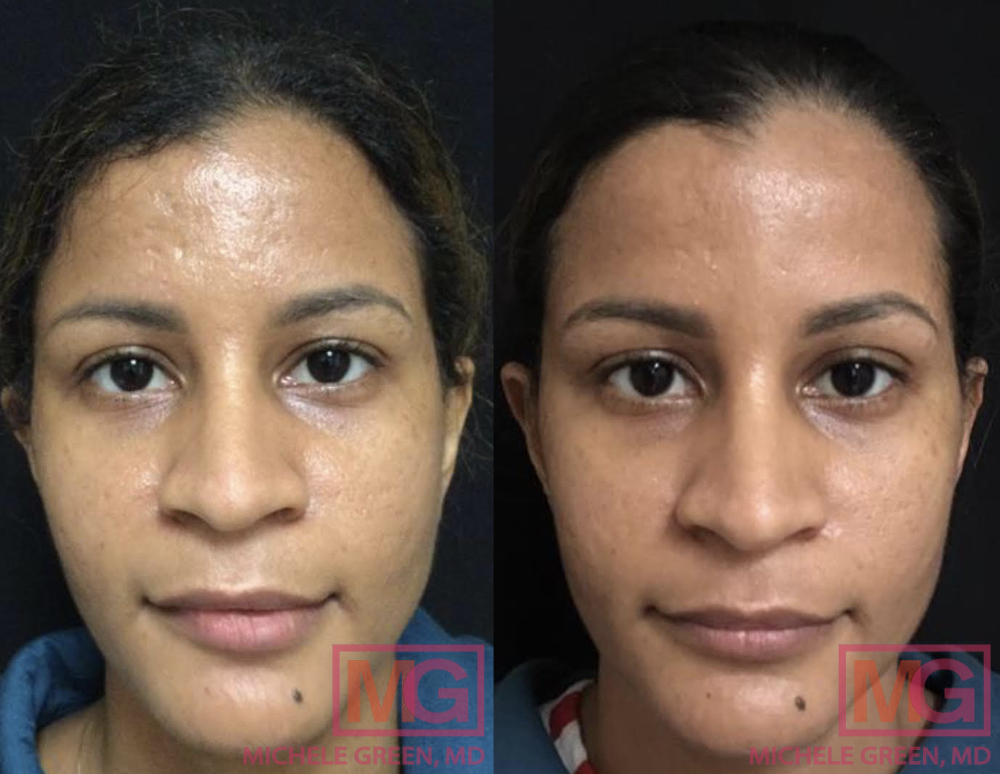
How to get rid of boxcar acne scars
Boxcar scars are round or oval-shaped in appearance and have deep vertical sides. Boxcar scars are wider in appearance than ice-pick acne scars. Boxcar scars develop when inflammatory acne destroys the collagen fibers within the skin. This type of acne scar leaves a depression in the skin due to that collagen loss. This loss of collagen frequently results in a sunken appearance of the skin due to a lack of tissue support. Boxcar scars can be either superficial or deep, depending on the amount of skin atrophy caused by inflamed and infected acne lesions. Dr. Green recommends several cosmetic treatments for her patients with boxcar scars, including dermal fillers, punch excision, punch grafting, TCA cross, and laser treatment. During your acne scar treatment consultation with Dr. Green, she will evaluate your acne scars and help you to determine which combination of treatment options is best suited to your specific skin concerns and skin tone, skin type, and the types of acne scars present.
Can TCA cross make scars worse?
When you have TCA cross-treatment with a board-certified dermatologist, like Dr. Michele Green in NYC, the result is a smoother complexion and visible reduction in acne scars. Patients with a history of keloid scars should refrain from having TCA cross performed, as the procedure may worsen the appearance of the skin’s texture instead of improving it. An incorrect or poor TCA cross technique may cause the appearance of scars to worsen, which is why it is always recommended to have treatment with an expert, such as Dr. Green. In some patients, the appearance of acne scars may slightly worsen before improving as part of the healing process. When you work with Dr. Green for your TCA cross-acne scar treatments, she will regularly evaluate your progress to ensure you achieve and maintain healthy, smooth, clear skin.
Is TCA cross good for acne scars?
TCA Cross is a safe and effective treatment option for certain types of atrophic acne scars called ice pick acne scars and boxcar scars. Ice pick acne scars get their name due to their deep, narrow appearance and for looking as though they were created with a sharp puncturing tool, like an ice pick. Boxcar scars are round or oval-shaped in appearance and have deep vertical sides. Boxcar scars are wider in appearance than ice-pick acne scars. Typically, a combination treatment approach is required to achieve optimal cosmetic results. When you consult with board-certified dermatologist Dr. Michele Green at her private dermatology office in Manhattan’s Upper East Side neighborhood, she will work with you to develop a personalized acne scar treatment plan best suited to your skin type, skin tone and types of acne scars you have to achieve and maintain healthy, smooth, clear skin that lasts.
How long does it take to see results from TCA cross?
The results from a TCA cross-treatment can be observed in as little as several weeks. Some patients observe a great improvement in the appearance of their scars after the first treatment session, whereas others may not see significant improvement until after several sessions. Dr. Green recommends waiting four weeks between each treatment session of TCA cross so that the progress can be evaluated at each follow-up appointment. If there is no observable cosmetic improvement following the third treatment session, Dr. Green recommends discontinuing that treatment option.
How many TCA peels to remove acne scars?
On average, patients with moderate acne scars require 3-6 treatment sessions of TCA cross or TCA peels to achieve optimal cosmetic results. The exact number of treatment sessions will ultimately depend on the severity of one’s acne scars. Patients with more numerous or severe scars will require additional treatment sessions than those with fewer and less severe scars. Patients with deep acne scars may require more than the average number of treatment sessions for desired results. When you consult with board-certified dermatologist Dr. Michele Green at her private dermatology office in Manhattan’s Upper East Side neighborhood, you will have the opportunity to discuss with her in-depth your specific skin concerns and aesthetic goals. Dr. Green will work with you to create a personalized treatment plan for skin rejuvenation that incorporates a combination of in-office procedures and specially formulated skincare products for achieving and maintaining healthy, smooth, clear, and radiant skin.
Are TCA cross results permanent?
The cosmetic results that are achieved with TCA Cross are permanent. However, TCA cross can not prevent new signs of aging from developing or the future breakdown of collagen in the skin, which is a natural part of the aging process. Many patients treated for acne scars choose to engage in other skin rejuvenation treatments, such as laser treatments, microneedling, dermal fillers, and more, over time to maintain the best cosmetic results. When you consult with board-certified dermatologist Dr. Green, she will work with you to develop a customized treatment plan and establish a timeline for your treatments that caters to your specific concerns and unique aesthetic goals.
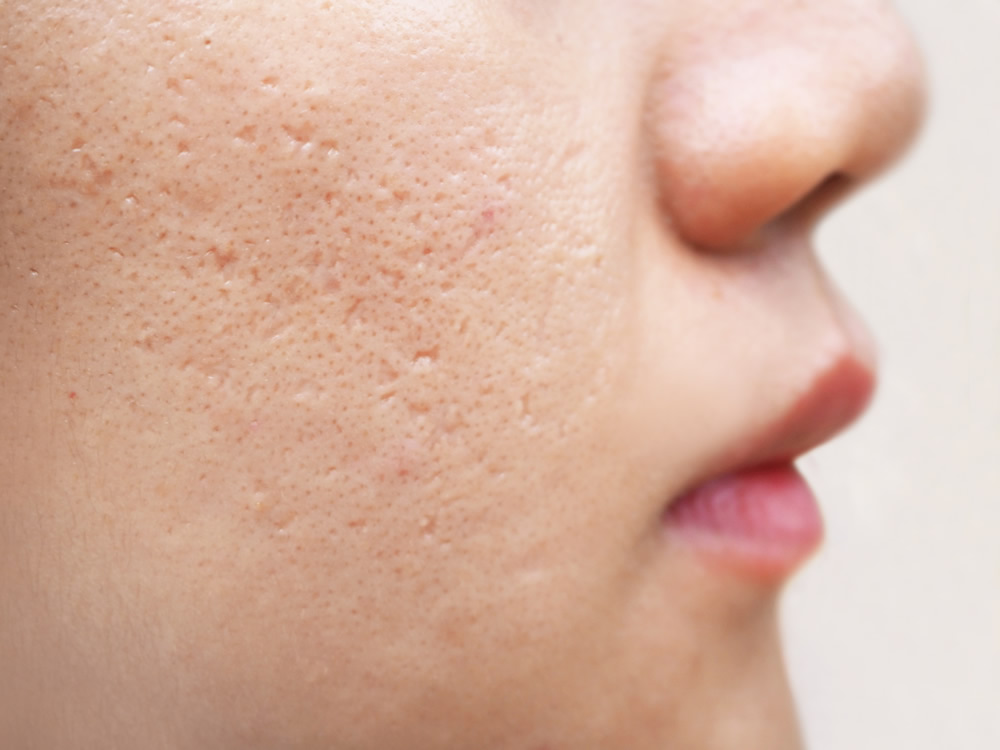
How much does TCA cross cost?
Ultimately, the final cost of TCA cross-treatment will be influenced by several contributing factors, including the geographic location of the office in which you are treated, the experience level of your provider, and the number of treatment sessions required to produce your ideal cosmetic results. Although it is often more costly to have acne scar treatment with a very experienced board-certified dermatologist, such as Dr. Green in NYC, it is always recommended to have scar revision with an expert. Acne scar treatments performed incorrectly, poorly, or on the wrong skin tone or skin type can cause unwanted side effects such as hyperpigmentation and scarring. During your consultation for acne treatment with Dr. Green in her private dermatology office, located in the Upper East Side neighborhood of Manhattan, you will discuss in-depth your medical history and any previous treatments you may have had. You will then have the opportunity to develop with Dr. Green a customized acne scar treatment plan that works best for your skin tone, skin type, and the types of acne scars you have. At that time, the total cost of your acne scar treatment can be better estimated.
How do I get started with TCA cross?
Acne scars can be a frustrating reminder of a bothersome breakout and, for many, may induce feelings of self-consciousness. Acne scars can be challenging to treat, and the acne scar treatments incorporated into your treatment plan should consider your skin type, skin tone, and the types of acne scars present. An experienced, knowledgeable board-certified dermatologist, such as Dr. Green in New York, can customize your acne scar treatment plan so that it is best suited to your needs. TCA cross is a type of acne scar treatment offered at Dr. Green’s private dermatology office in Manhattan’s Upper East Side that works to reduce the appearance of icepick scars and boxcar scars.
Dr. Michele Green in NYC is an internationally renowned board-certified cosmetic dermatologist with over two and a half decades of experience providing some of the world’s most discerning men and women with the best non-invasive rejuvenation treatment options available, including TCA cross for acne scars, laser treatments, dermal fillers, Botox, microneedling, and more. For her dedication to her patients and expertise, Dr. Green is consistently identified as one of New York City’s best dermatologists by Castle Connolly, New York Magazine, and Super Doctors. When you consult with Dr. Green for your acne scar treatment, she will work with you to create a customized treatment plan that incorporates the combination of in-office procedures and specially formulated skincare products best suited to your specific skin concerns and aesthetic goals. To get started with your personalized acne scar treatment plan with Dr. Green in NYC, call the office at 212-535-3088 or contact us online today.
 212-535-3088
212-535-3088 